TECHNOLOGY VS HUMANITY by Gerd Leonhard
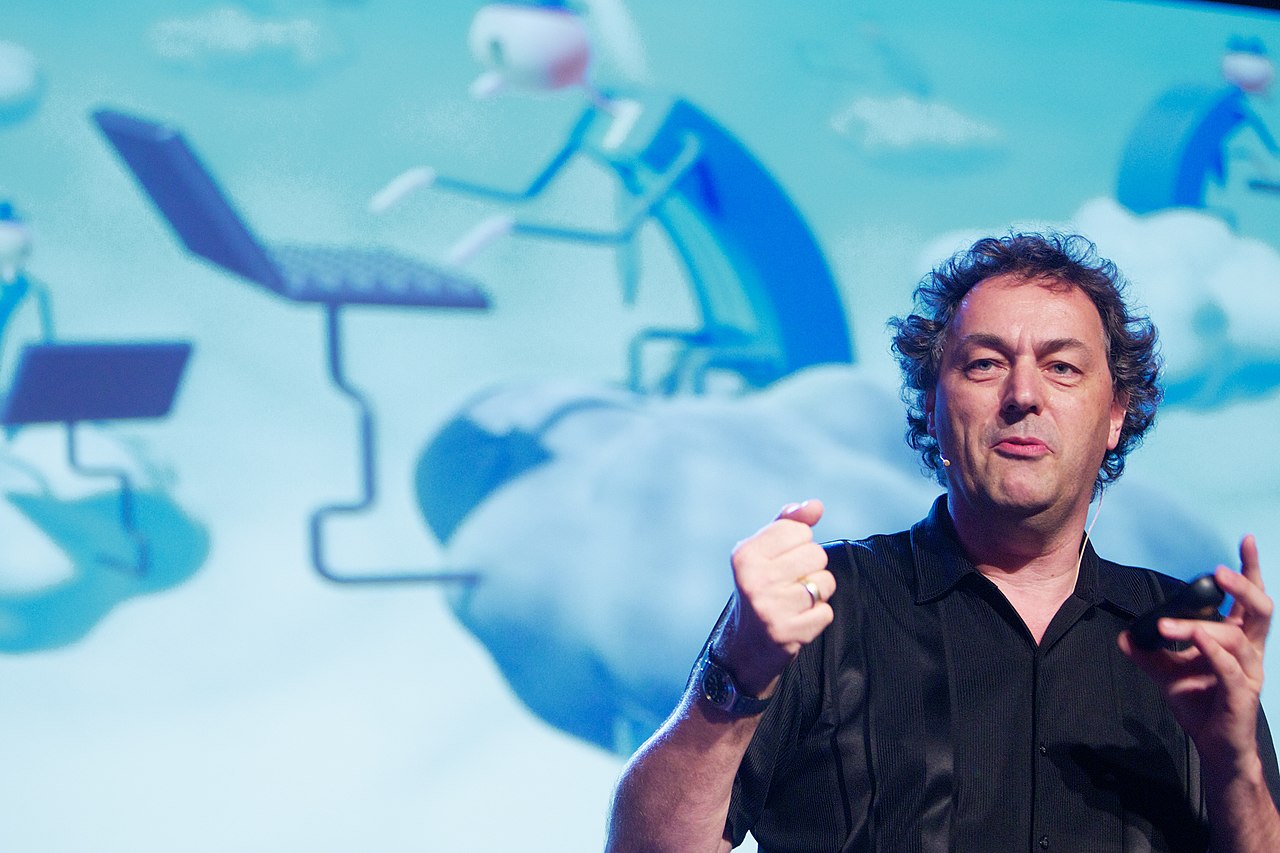
Perhaps I am unconscious, but my view of the impact of technology on humanity is far from the “hell on earth” (HELLVEN) perspective that Gerd Leonhard describes in his book TECHNOLOGY VS HUMANITY.
Being aware of the risks of exponential technological evolution (such as the concentration of power that Jaron Lanier describes in Who Owns the Future?, see “Who Owns the Future?”), I believe that Leonhard’s apocalyptic views promote fear and paralysis regarding the current technological evolution.
Something that, on the other hand, is impossible.
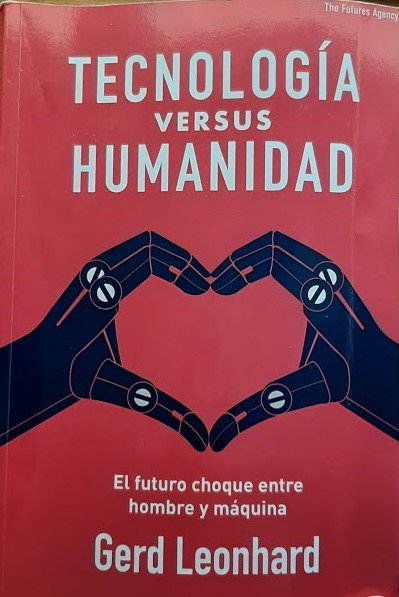
Technology vs Humanity by Gerd Leonhard
That said, Technology vs Humanity contains interesting reflections that I will echo in this summary.
GERD LEONHARD, THE AUTHOR
Gerd Leonhard has been a musician and founder of LicenseMusic.com. He currently calls himself a “futurist” and has become a recognized brand for his peculiar vision of the future.
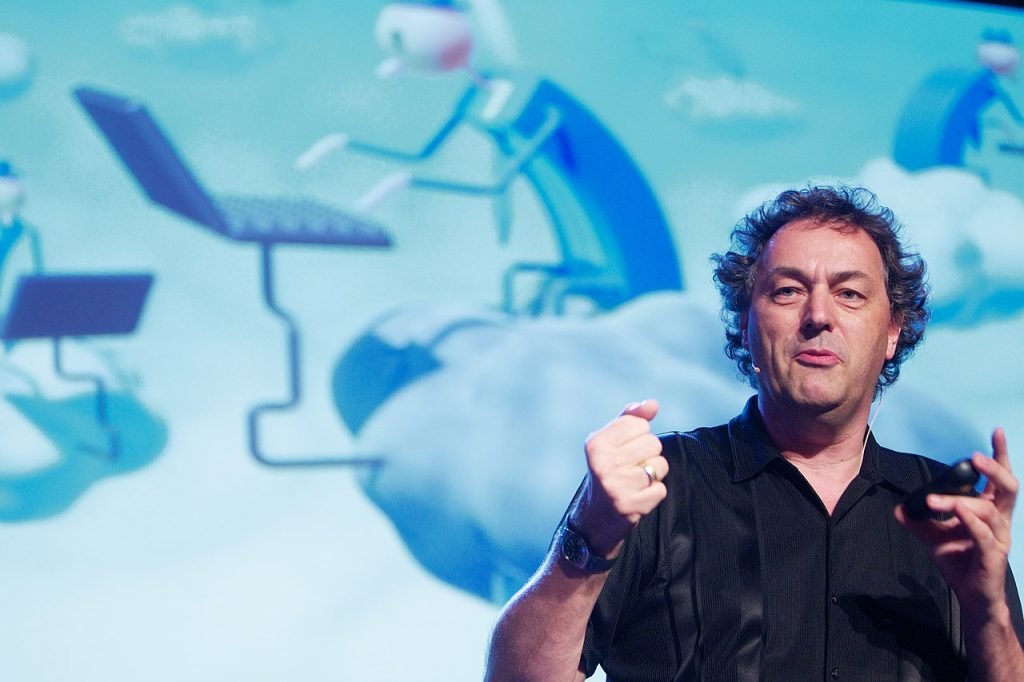
Gerd Leonhard presenting Technology vs Humanity
After his beginnings as a musician, he wrote books and articles about the transformation of music from its conception to its distribution.
In recent years, I have followed his trajectory through in-person talks (Enlighted 2018) and videos. He has generated interesting multimedia content regarding digital transformation, disruption, exponentiality, and other topics related to technology vs humanity.
I recommend his website “futuristgerd.com” as a source of valuable resources, such as the following video on the impact of Digital Transformation.
With all this, I owed it to myself to read his latest book, Technology vs Humanity, which this post is about.
TECHNOLOGY VS HUMANITY, THE BOOK
Technology vs Humanity invites us to reflect on the clash that, according to Gerd Leonhard, is occurring between humans and machines. It makes us think about the questions: what will happen to us when everything is technology? and what limits should be imposed on technology to avoid losing our humanity?
To this end, the book begins by addressing what he considers the greatest challenge for humanity: the confrontation between exponentially advancing technology and humanity, which evolves linearly.
It continues by describing the 10 mega-changes we face (including digitization, mobilization, disintermediation, automation, and virtualization) along with the societal effects of the combination of these mega-changes.
Subsequently, Gerd Leonhard discusses the concept of digital ethics and dares to predict, since 2016, the evolution of society between 2020 and 2030, indicating the main technological changes that will occur every two years.
Technology vs Humanity concludes with a chapter dedicated to decision-making: are we on the machines’ team or on the human team?
TECHNOLOGY VS HUMANITY, A 3-MINUTE SUMMARY
For those who prefer 3-minute bites, in the following video, Gerd Leonhard himself summarizes the starting point of this futuristic and dystopian vision in which, if we are not careful, in 20 years, humans will lose our human essence and become tools of our own tools.
THE GREATEST CHALLENGE FOR HUMANITY
Humanity will change more in the next 20 years than in the last 300 years
Gerd Leonhard
With this phrase, Gerd Leonhard summarizes the challenge we face.
Building on Moore, Metcalfe, and Gilder (see “The Origin of Digital Transformation: Moore, Metcalfe, and Gilder”), Leonhard describes the current situation as a point of exponential inflection where advances in many fields of science and technology are doubling every 18-24 months.
This exponential progress is compounded by its combinatorial effect, as these advances are not isolated but rather combined and integrated, as well as recursive, given that technologies like Artificial Intelligence have the potential to self-amplify.
Gerd Leonhard visualizes the current situation with a 90/10 ratio: 90% of the effects of technology are positive, and 10% are negative. However, he fears that exponential, combinatorial, and recursive evolution could lead to a reversal of this ratio.
In light of this challenge, in Technology vs Humanity, Leonhard argues that we cannot adopt a passive “wait and see” attitude but must take control and set global standards that determine the direction of this evolution.
The goal should be the achievement of human happiness, understanding happiness from a global perspective and not hedonistic and momentary pleasure.
THE 10 MEGA-CHANGES
According to Leonhard, there are currently 10 mega-changes taking place that represent a significant evolutionary leap for society. These changes are first observed gradually (initial advances on the exponential curve) and then suddenly (from a tipping point on the exponential curve).
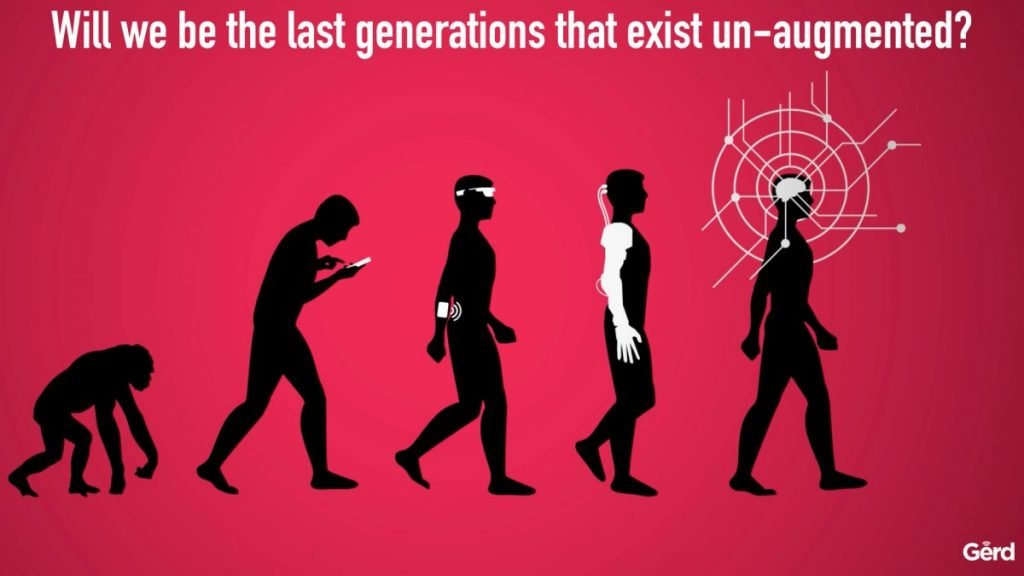
Technology vs Humanity by Gerd Leonhard
These 10 mega-changes - 10 sounds very round - are:
- Digitization: everything that can be digitized will be. Including human relationships.
- Mobilization: everything that can be mobilized will be: connectivity is our oxygen, and computing is our water.
- Screenification: everything we used to consume in print is migrating to screens. Through Augmented and Virtual Reality, screens will evolve away from the flat surface we currently use.
- Disintermediation: the elimination of intermediate levels in the value chain, often concentrating power in new players (for example, UBER in urban mobility).
- Transformation: we are not talking about mere changes or innovations but rather that our companies are fighting to become what will work in 5 or 10 years.
- Intelligentization: everything is becoming intelligent through data and AI.
- Automation: as a central idea to achieve hyper-efficiency by replacing humans with machines.
- Virtualization: from the virtualization of products and services (see “What are digital products, servitization, and other demons?”) to the creation of digital versions of ourselves that interact in virtual worlds parallel to the real one.
- Anticipation: computers are becoming increasingly efficient at predicting our needs (a clear example is Google’s route suggestions, travel recommendations, reminders of past images, etc.). The consequence for individuals of these technologies is dependency, confusion (is it a person or a machine?), loss of control (what would have happened if I had not followed the suggested route?), and abdication (delegating increasingly significant actions).
- Robotization: the convergence point of all the above.
A NEW ATOMIC BOMB
In Technology vs Humanity, Gerd Leonhard likens the current situation to that of 1940.
He explains how Albert Einstein and other scientists urged President Roosevelt in 1940 to accelerate the construction of the nuclear bomb with the goal of having it before the Germans. In 1954, five months before his death, Einstein remarked:
I made a great mistake in my life (…) when I signed that letter to President Roosevelt (…)
Albert Einstein
Because:
- Technology is neither good nor bad.
- Technology has no ethics.
- Technology simply is. It is the good or bad use of technology that makes the difference.
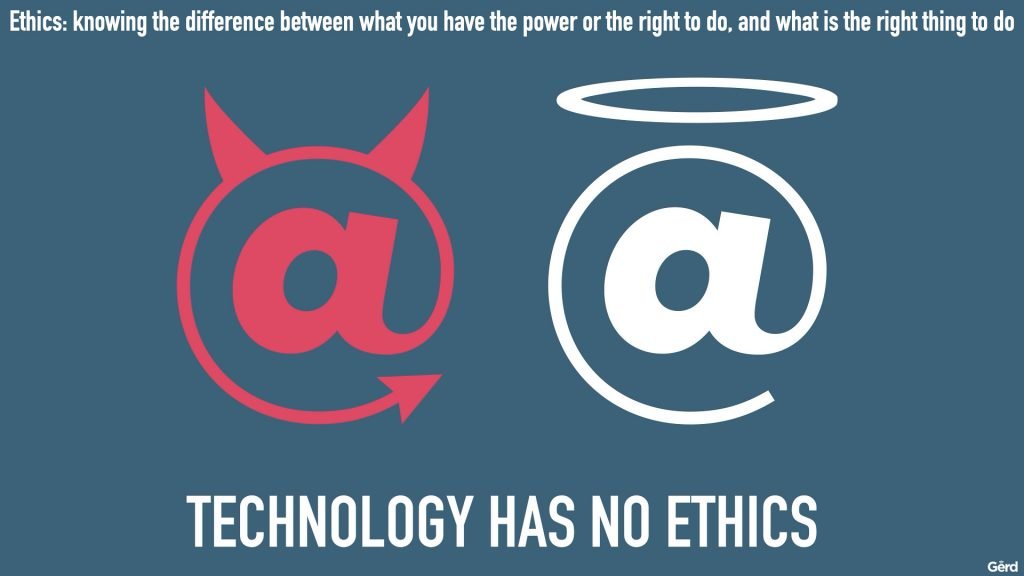
Technology vs Humanity: digital ethics
When referring to high-risk exponential technologies such as General Artificial Intelligence, Geo-engineering (climate control through technology), autonomous weapon systems, genetic modification of humans, or enhancing human capabilities through technology implantation, he considers our attitude to be akin to that of scientists in 1940.
“The human spirit must prevail over technology”
Albert Einstein
FROM THE MAGICAL TO THE MANIC AND FINALLY TO THE TOXIC
In Technology vs Humanity, Gerd Leonhard describes our relationship with these technologies as a progression from the magical (with contributions that surprise us with their positive short-term effects) to the manic (total integration into our lives) and finally to the toxic (with unforeseen, dramatic, and harmful consequences).
In this process, individuals will transition from being creators of tools (technology) to becoming tools of our own tools.
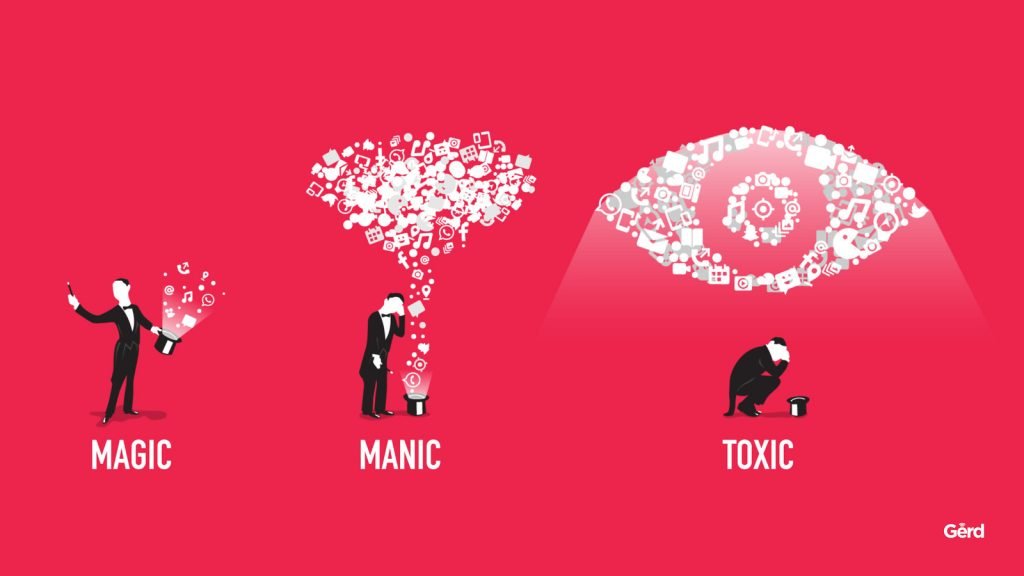
Illustration by Gerd Leonhard
Gerd Leonhard does not follow the stereotypes of science fiction.
Technology vs Humanity does not describe the future society as a world where people are slaves to a malevolent Artificial Intelligence but rather a society in which people abandon themselves in a digital world until they lose their humanity.
In this infinite technological orgasm, people would become the reproductive mechanism of technology and abandon such human aspects as human gestation through the use of artificial wombs in the absence of natural mothers via ectogenesis.
The image reminds me of the science fiction series Humans by AMC. In it, some people decide to behave like robots because they consider themselves superior to humans. In addition, this way, they stop worrying about their more human feelings.
DIGITAL ETHICS
One of the foundations of the book Technology vs Humanity is that technology has no ethics. It is its use that determines whether it is good or bad.
For this reason, Gerd Leonhard argues that in every technological advancement, the impact that a misuse of it could have on society should be analyzed.
“The safest, and even the most promising future, is one in which we do not postpone innovation, but where we also do not ignore the exponential risks that currently come from treating them as if they were ‘someone else’s problem.’”
Gerd Leonhard
Leonhard promotes analyzing whether the advancement will be positive for society as a whole or only for the 1% of people who produce it.
Also, whether these advancements will be universally accessible or only to the wealthiest group, increasing social disparities and, consequently, tensions.
An example of the latter is the consideration of death as a disease that we can cure, thereby achieving immortality. An immortality likely only accessible to those with greater economic resources on a planet with limited resources.
The social tensions that technologies of longevity like those that Peter Diamandis and his Human Longevity Inc. are trying to create could necessitate a reconsideration of those principles.
In Technology vs Humanity, ethics is described as a human quality that machines will never understand.
In light of this problem, two approaches are presented:
- Be cautious regarding technological advancements in line with what has been described above.
- Create a basic ethics that we can teach to machines.
This latter approach reminds me of the rules defined in the 1940s and 50s in classic books by Isaac Asimov. In them, Asimov developed the three basic rules of robotics:
- FIRST LAW: A robot may not injure a human being.
- SECOND LAW: A robot must obey the orders given it by human beings except where such orders would conflict with the First Law.
- THIRD LAW: A robot must protect its own existence as long as such protection does not conflict with the First or Second Law.
In Technology vs Humanity, Gerd Leonhard advocates for the creation of a Global Council for Digital Ethics around five new human rights for the digital age:
- Right to remain natural, that is, biological.
- Right to be inefficient when this is part of our human essence.
- Right to disconnect.
- Right to be anonymous.
- Right to employ people instead of machines.
THE TIME TO DECIDE
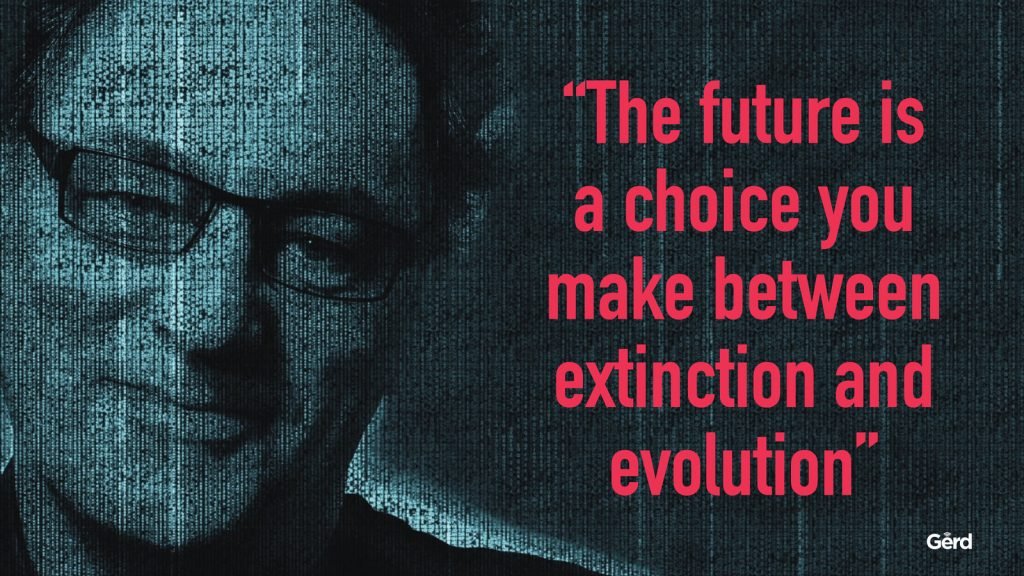
Technology vs Humanity: the time to decide
Technology vs Humanity concludes with a futuristic journey from 2020 to 2030 and a forceful conclusion:
Are you on the human team?
Gerd Leonhard in Technology vs Humanity
In a world of nuances, the question is entirely binary: you are either with technology or with humanity.
CONCLUSIONS
While I agree with Gerd Leonhard on the magnitude of the challenge we face and the importance of defining a digital ethics that serves as support, I do not concur with his catastrophic view of technological evolution, although I interpret it as a wake-up call.
As psychologist and Nobel laureate in Economics Daniel Kahneman stated (see “Artificial Intelligence vs Human Intelligence”), I see no reason to set a limit on what Artificial Intelligence can achieve. This seems extrapolable to most technological advancements that Technology vs Humanity warns us about.
It may be necessary to impose limits on the use of some of them to avoid encountering a new atomic bomb, but we should not take a stance that radically hinders progress.
Otherwise, we would be paving the way for a clandestine research industry in certain sciences or technologies, as happens in the case of cybersecurity and cybercrime.
Also, the concentration of power that the logic of “From Zero to One” by Peter Thiel generates in the large digital giants (“siren servers” according to Jaron Lanier, see “Who Owns the Future?”) requires attention.
In my opinion, Gerd Leonhard skims over the risks associated with this concentration of data and power.
I consider his approach to the risks of technology a provocation that seeks to create a sense of urgency and provoke debate.
That debate concerns the creation of an ethical code and a global body to promote it. That global body, a sort of UN for digital ethics and human rights in the digital age, would be the “Global Council for Digital Ethics” that he advocates.
REFERENCES
Below are the references used in this post:
- Book “Technology vs Humanity: The Future Clash Between Man and Machine” – Gerd Leonhard
- WEB TechVsHuman.com
- WEB of Gerd Leonhard (including the graphic resources of this post)
- YOUTUBE of Gerd Leonhard
- Digital-rocks.com: Who Owns the Future?
- Digital-rocks.com: The Origin of Digital Transformation: Moore, Metcalfe, and Gilder
- Digital-rocks.com: What are digital products, servitization, and other demons?
- Digital-rocks.com: Artificial Intelligence vs Human Intelligence
CHRIS CORNELL
While reading Technology vs Humanity, it marked three years since the passing of Chris Cornell, a unique vocalist who combined fragility, emotion, and darkness.
His departure seemed particularly tragic to me because after overcoming years of grunge and excess, he seemed to have achieved that status of rock superstar. With a responsible image and as a doting father, he enjoyed his tours with the company of his daughter both on and off stage.
The “risk” seemed far away.
In the 80s and 90s, he made us explode alongside Soundgarden and demonstrated the qualities of his voice with Temple of the Dog.
Soundgarden will always be associated with the names of Nirvana (see “Nirvana: my lost concert”), Pearl Jam, Alice in Chains, and Stone Temple Pilots, among others. Of all of them, only one, Pearl Jam, remains intact.
In his last phase, I was able to enjoy him several times with Audioslave, where he joined forces with another superband of the time: Rage Against the Machine. He also delighted us with melodic songs in his solo career until his farewell with the soundtrack of The Promise.
I leave you with Hunger Strike by Temple of the Dog, in which he participates in a vocal duel with his friend Eddie Vedder. Enjoy.
Related posts

From COBOL to Agentic AI: Transforming the Software Lifecycle
Evolution of the software lifecycle applying AI and Agentic AI

Digital Transformation: Beyond Technology
In Digital Transformation, purpose and culture are more important than technology itself.

PROTOPÍA: get familiar with the term
> "Let's avoid the DYSTOPIA (...) > "Let's avoid the DYSTOPIA (...)
All opinions expressed on this blog are personal and do not represent those of any company or organization with which I collaborate.
